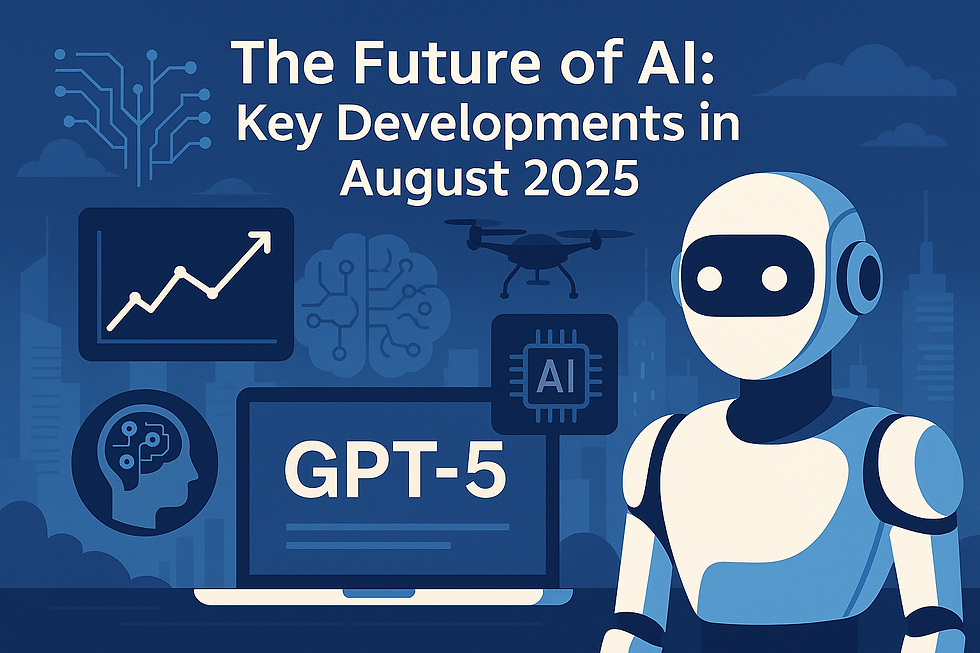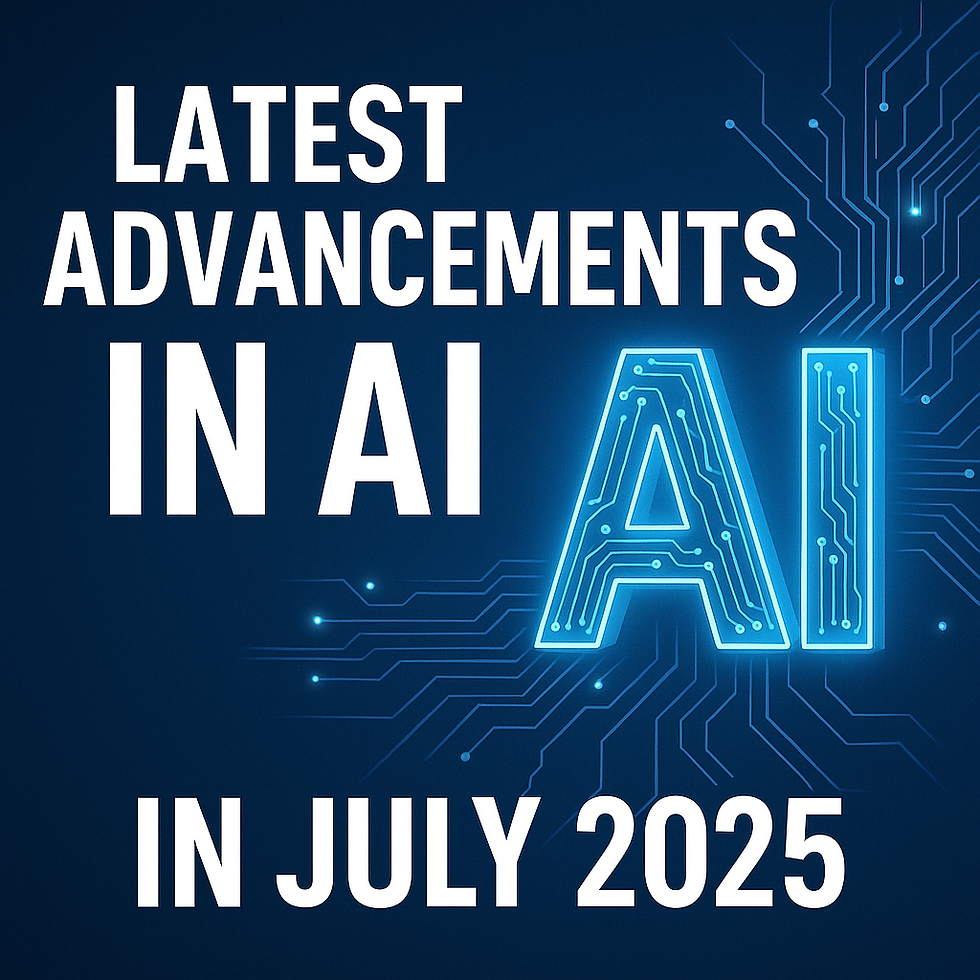September 2025: AI's Hottest Breakthroughs – The Month That Supercharged Everything!
- Muhammad Nouman Attique

- Oct 6
- 4 min read
September 2025 was a landmark month for artificial intelligence, with breakthroughs spanning multimodal models, infrastructure megadeals, and consumer-facing innovations. From video generation to agentic search and privacy-first on-device AI, the field took massive leaps forward. Drawing from the latest reports and discussions across the web and platforms like X, here’s an in-depth look at the top advancements that defined the month and their implications for the future.
1. OpenAI’s Sora 2: Redefining Multimodal Creativity
OpenAI unveiled Sora 2, a next-generation video and audio generation model that pushes the boundaries of creative AI. Unlike its predecessor, Sora 2 integrates realistic physics simulations—think objects that move, collide, and bounce with lifelike accuracy, like a ball obeying gravity or water rippling naturally. It also syncs audio tracks seamlessly with generated visuals, enabling creators to produce Hollywood-quality short films from simple text prompts. Early demos showcased on X highlight its ability to generate 4K-resolution clips with dynamic lighting and spatial audio, making it a game-changer for filmmakers, game developers, and content creators. Sora 2’s API is already being integrated into creative platforms, signaling a shift toward democratized, high-fidelity media production.
Impact: Expect a surge in AI-driven content creation, from indie films to immersive VR experiences, as barriers to professional-grade production continue to fall.
2. Anthropic’s Claude Sonnet 4.5: The Developer’s Dream
Anthropic released Claude Sonnet 4.5, a model optimized for complex reasoning, coding, and agentic workflows. Benchmarked against competitors, it outperforms in tasks like multi-step problem-solving and software development, making it a favorite among developers building autonomous agents. Posts on X praise its ability to generate clean, debug-ready code for languages like Python, Rust, and Go, reducing development time significantly. Additionally, Microsoft announced integration of Sonnet 4.5 alongside Claude Opus 4.1 into its Copilot suite for enterprise users, enhancing productivity tools with real-time code suggestions and data analysis capabilities. This move solidifies Anthropic’s position as a leader in practical, developer-focused AI.
Impact: Developers and enterprises will accelerate adoption of AI-driven coding assistants, potentially reshaping software development workflows and reducing reliance on traditional IDEs.

3. ByteDance’s Seedream 4.0: Image Generation at Lightning Speed
ByteDance’s Seedream 4.0, a text-to-image and image-editing model, made waves in China and beyond with its 10x faster inference speeds compared to previous iterations. Benchmarked against Google’s Gemini 2.5 Flash, Seedream 4.0 delivers superior image quality and editing precision, handling tasks like style transfer and inpainting with unprecedented efficiency. Available through apps like Jimeng in China, it’s poised to challenge global players like DALL·E 3 and MidJourney. Discussions on X highlight its ability to generate photorealistic portraits and intricate fantasy landscapes, with rumors of an impending global rollout. ByteDance’s focus on low-latency inference could set a new standard for real-time creative AI applications.
Impact: Faster, high-quality image generation will empower industries like advertising, gaming, and e-commerce, while global expansion could intensify competition in the creative AI space.
4. OpenAI and NVIDIA’s $100 Billion Infrastructure Bet
In a historic partnership, OpenAI and NVIDIA announced a $100 billion deal to build 10 gigawatts of AI infrastructure, powered by millions of GPUs based on NVIDIA’s Vera Rubin architecture. The first gigawatt is slated to come online by late 2026, with the full project expected to transform AI model training and deployment. According to reports, this infrastructure will support the scaling of next-generation models, potentially paving the way for advancements toward artificial general intelligence (AGI). Posts on X emphasize the deal’s scale—equivalent to the power output of several nuclear plants—underscoring its ambition to meet the computational demands of future AI systems.
Impact: This partnership will accelerate the development of larger, more capable models, but it also raises questions about energy sustainability and access to such resources for smaller players.
5. Google’s Gemini 2.5: Agentic Search Goes Global
Google rolled out Gemini 2.5, powering its AI Mode to over 180 countries with features like agentic search, conversational voice chat, and enhanced search overviews. Unlike traditional search, Gemini 2.5 acts as a proactive assistant, executing tasks like booking flights or drafting emails based on user queries. Its integration into Google’s ecosystem—spanning Search, Maps, and Assistant—makes it a versatile tool for both consumers and businesses. X users have shared examples of Gemini 2.5 solving complex queries, such as planning multi-city travel itineraries or generating code snippets on the fly. The model’s multilingual capabilities and low-latency responses position it as a direct competitor to ChatGPT and Grok in the conversational AI space.
Impact: Agentic search will redefine how users interact with the internet, shifting from passive queries to proactive, task-oriented assistance, with ripple effects across industries like travel, education, and customer service.
6. Apple Intelligence: On-Device AI Gets Smarter and More Personal
Apple doubled down on its privacy-first AI strategy with the latest updates to Apple Intelligence, integrated into iOS 19. New features include Live Translation for Messages and FaceTime, Visual Intelligence powered by ChatGPT for real-time object recognition, and Genmoji for creating custom emojis from text prompts. Expanded to eight additional languages, including Hindi and Arabic, Apple Intelligence now reaches a broader global audience. On-device processing ensures data privacy, a key differentiator from cloud-based competitors. X posts highlight user excitement over features like AI-enhanced photo editing and personalized notification summaries, which streamline daily tasks without compromising security.
Impact: Apple’s focus on on-device AI will push competitors to prioritize privacy, while its consumer-friendly features could accelerate mainstream adoption of AI in everyday devices.
Looking Ahead: The Road to October and Beyond
September 2025 showcased AI’s evolution from experimental tech to a cornerstone of creativity, productivity, and infrastructure. As models like Sora 2 and Seedream 4.0 redefine content creation, and megadeals like OpenAI-NVIDIA reshape computational landscapes, the stage is set for even bolder advancements. October could bring further integration of AI into wearables, autonomous vehicles, or even healthcare diagnostics, as hinted in recent X discussions. Ethical considerations, energy consumption, and equitable access to AI tools remain critical challenges, but the momentum is undeniable .
What’s your take on these breakthroughs? How do you see AI shaping the rest of 2025? Share your thoughts and predictions below! 🚀 #AIRevolution #Tech2025 #FutureNow
.png)



Comments